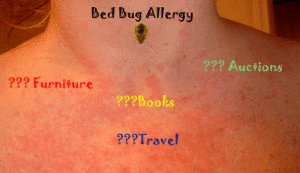The other night when I came home, I felt like Tippi Hedren in the 1963 Alfred Hitchcock horror movie, The Birds. In the movie, Tippi Hedren was attacked by birds on the front porch.
For me, there wasn’t anything unusual about that night for Tucson, Arizona. It had rained a few nights before, but I wasn’t feeling any of the after effects from it. It was a typical warm summer night – after a very hot day.
As I arrived on my property, as usual I got out of the car to unlock the gate. As I was unlocking the gate, bugs were flying around me, which I first thought were gnats. The longer I stayed at the gate, the more there were and they were starting to land on me and attach themselves to my shirt. That’s when I noticed they were kissing bugs. I repeatedly swatted them and flung them off. I rushed to unlock the gate and I got back in the car as fast as I could because I know the bites of kissing bugs can be dangerous. Some of the kissing bugs followed me inside the car.
As I was driving through the entrance way, I noticed that the front hood of the car was covered with hundreds of them. After I drove through the entrance way, once again I had to get out of the car, this time to lock the gate. Again I was attacked by the kissing bugs only in larger numbers. I now noticed the entire outside of the car was covered with them, even walking up the sides. I hate coagulation, so this was all a horrible and disgusting sight for me. I quickly got back in the car and drove to my house. It was so distracting to drive with the kissing bugs crawling up the windshield, seeing them all over the front hood and having them land on me inside the car. I felt so itchy, to add to the sweatiness I was also feeling from the warm summer night here in the desert. It felt like I had bugs crawling on me in areas that I actually didn’t, when I looked.
Once I parked and turned off the car’s headlights, the kissing bugs started to fly around. As I was taking the grocery bags out of the trunk of the car, the kissing bugs surrounded me and some kept landing on me and once again sticking to my shirt. I continued to swat and fling them off. As I carried grocery bags inside the house, I noticed kissing bugs were in the grocery bags. Before going in the house, I tried killing all the kissing bugs that were inside the car, but I couldn’t get to them all, so I only left a few. They were all just too much to deal with and at one point, I had to give up and let them be. A usually pleasant and relaxing experience of coming home turned out to be horrible and exhausting – and very unusual.
For days afterwards, I continued to kill kissing bugs inside my house.
It is not uncommon to see a few kissing bugs inside and outside of your home here in Tucson Arizona, but in the almost 30 years I’ve lived here, I’ve never seen such an infestation and had that many of them directly all around me.
What is a kissing bug?
A kissing bug is a bug that feeds on vertebrate blood. They are blood-suckers, just like mosquitoes, ticks and tse-tse flies. Kissing bugs get their name because they usually bite people near their mouth during the night while they sleep. The main reasons for this is that the kissing bugs are attracted to the smells such as the carbon dioxide that we exhale and the smells different parts of our body emit – such as our hair, skin and face and they are attracted to the heat of our bodies. They usually bite a person’s face at night because our face is most likely the only exposed area of skin while we sleep. Most kissing bugs hide during the day and search for blood during night when their victim is asleep and the air is cooler. Outdoors, they usually feed just after sunset. It’s interesting that they are attracted to the heat of our breath and bodies, but in contrast, they come out of hiding at night because the air is cooler.
Kissing bugs fly. As they fly, kissing bugs are usually first attracted to light. Maybe the headlights of my car are what first attracted them that night. Porch light, or lights from house windows will attract kissing bugs flying nearby. After they reach the house, they will find a way to enter the house and once inside feed on people and pets. Don’t worry about kissing bugs being in your bed because they usually don’t hide under covers like some other bugs, or spiders do. Usually after the kissing bug sucks blood, it doesn’t move around as much. This is when they can easily be seen, identified and killed.
How do you identify a kissing bug?
A kissing bug is very easy to identify. They range in size and some are quite small. They are black and all around the edge of their back wing is a red line.
Why are kissing bugs common here in Southern Arizona?
Here in Southern Arizona we have pack rats, which make many nests on and under the desert ground. Most kissing bugs are found in these packrat nests. Packrat nests provide the kissing bugs with a readily available supply of blood – the packrats themselves, and it provides them with shelter from other insects, rodents, etc., if the packrats don’t eat them first. They also live in ground burrows with other rodents. Kissing bugs are also known to live in trees with birds and bats.
Why are kissing bugs harmful in Southern Arizona?
It is the salivary proteins the kissing bug injects as it bites, that may cause allergic reactions in people. The allergic reaction to the bite of the kissing bugs can range from moderate to life-threatening, depending on the sensitivity of their victim. In my family alone, three people are allergic to kissing bug bites. I have seen one family member’s face, including her lips swell. Some of the common non-threatening allergic reactions include, but are not limited to: skin redness and irritation, flushing, nausea, vomiting, and diarrhea. Some of the more serious allergic reactions include, but are not limited to: wheezing, trouble breathing and shock. It is known that if your throat swells up as an allergic reaction and you are having trouble breathing, to immediately call 9-1-1. Because the kissing bug bite is painless and occurs at night, most people never know they have been bitten until they notice they are having an allergic reaction to something. Often sensitization develops as a result of being bitten repeatedly by kissing bugs.
Kissing bug bites can also emit a potentially deadly parasite either by a bite, or through an open wound their victim has, causing Chagas Disease. Chagas Disease initially feels like having the flu, but the long-term damage can be: enlargement of the liver or spleen, severe inflammation and infection of the heart muscle or brain, and life-threatening heart and/or digestive disorders.
How can kissing bug bites be prevented?
There is no immunotherapy available for sensitized individuals, but I know that it is recommended for those who know they are allergic to kissing bug bites to carry their own epinephrine pen – also called an EpiPen. A prescription is needed to obtain this pen.
The best you can do to avoid being bitten by a kissing bug is to try to prevent any kissing bug from having human contact. Keep your home and your property clean – inside and outside. If you see any packrat nests too close to your home outside, or where you frequent often, destroy them, so they have to move somewhere else. Also keep re-filling and covering if possible, the burrowed holes of any rodents in the ground. If you do see kissing bugs at night, check that area (during the day might be best) to see what might possibly be there which attracted them, or is providing them with shelter. Also check small, dark places during the day for any bugs that may be hiding. When I looked by the gate where I first experienced the huge kissing bug problem, I did see trails of packrat feces on the ground and several burrowed holes.
Inside your home, check around all the windows and doors for small openings, which can provide kissing bugs access into your home. Spray an insecticide and block those openings. Make sure all of your doors and windows have proper screens that fit tightly. When you have to open a door at night, open and close it quickly.
Porch lights, or lights from your windows are the biggest attractions to kissing bugs flying nearby. At night, keep any outside lighting to a minimum – hopefully turned off completely. Inside your home, keep your blinds or curtains closed at night, to reduce the possibility of the inside lights being seen from the outside of your house.
These small precautions can prevent 2 big problems – kissing bug infestation and harmful kissing bug bites.
Sources:
1. http://en.wikipedia.org/wiki/Kissing_bug August 17, 2010
2. http://www.neurobio.arizona.edu/kissingbug-facts.html 2008-2009
3. http://en.wikipedia.org/wiki/Chagas_disease August 9, 2010


